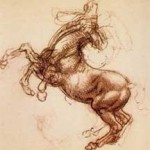 The heroine of The Legend of the Great Horse trilogy is resourceful, quick-witted and brave … her name is Meagan Roberts.
The heroine of The Legend of the Great Horse trilogy is resourceful, quick-witted and brave … her name is Meagan Roberts.
The trilogy follows the development of horsemanship in human history, and horses have given the world such rugged male icons as cowboys (and indians), knights in shining armor and cavalry charges, not to mention Ben-Hur. Yet my initial main character “Michael” kept dismounting to let Meagan aboard.
The story concerns a modern-day rider, and it is an unfortunate fact that young men in America today do not dedicate themselves to horsemanship in nearly the numbers that young women do … this comes after the majority of human history depicted horsemanship as a strictly male pursuit. Times change and horsemanship changes with it.
Discovering and writing a female hero was natural enough, as my former experience teaching riders meant coaching battalions of young women for every male. My idea for Meagan is the young college student who stays up all night grooming horses in return for a trailer ride to the next day’s competition. Meagan is the excited young girl whose straight-A report card finally convinces a carpool-weary parent to add one more stop at the stables. She is the shy adolescent whose eyes light up with confidence after a good round, the dependable ingénue who quietly keeps herself and her horses glowing, the serious junior who quietly listens and plans her way to success.
Horseback riding has historically been a respected, even hallowed method of youth development, turning out thoughtful, responsible leaders with empathy and depth of character for millennia. Meagan is a compilation of the qualities that horsemanship imparts: she is resourceful, diligent, fair-minded, and brave, and able to lead while engaging in both teamwork and strategic planning. These heroic qualities are all human virtues to be improved in the sandy classroom of our great teacher: the horse.


